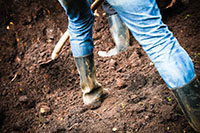Home Building Articles
Quick Tips to Rescue Your Garden & Beds from Water-Logged Soils
April 2016

Don't Work Wet Soil.
Working wet soil can do long term damage to the integrity of the bed/garden itself. Allow the soil to dry out for several days. Push a trowel into the
soil and wiggle it back and forth, if visible water is in the hole, or the soil looks glossy, wait a few more days.
Don't Rush to Replant.
Soil biology is damaged when soils are water-logged for long periods of time. This affects the availability of nutrients for plant use. If you must replant
quickly, support the biology with added compost type material.
Don't Rush to Prune.
Stress from water-logged soil my cause some leaves on trees and shrubs to yellow and drop off, but the branches are not necessarily dead. New leaf buds
will begin to grow in a few days. Wait until you are sure there is die-back before pruning.
Replace Nutrients.
A light fertilization will replace nutrients that have leached from the soil during heavy rainfall. Foliar feeding can quickly boost needed minerals to
reduce plant stress.

Be Prepared to Deal with Pests and Disease.
Water stress weakens plants. Weakened plants are susceptible to attacks. Fungal diseases are common after periods of heavy rain. Pull mulches back from
the base of trees, herbs/vegetables, etc. until it dries out. Be prepared to take quick action with fungicides and pesticides.
Make an Action Plan
One of the best things you can do after heavy rains is to assess your landscape. Get a clipboard and a camera. Make notes and take pictures of places
where water stand for long periods of time. Make a list of plants that seem more sensitive to wet soils. Use this information to help you make future
decisions such as raising beds, improving soil texture, and plant selection.